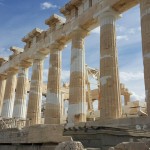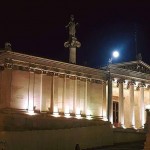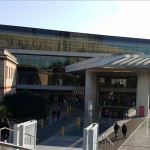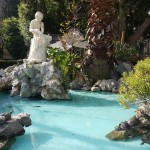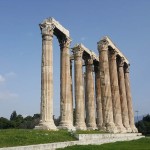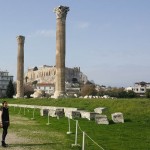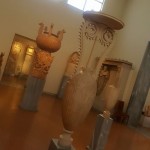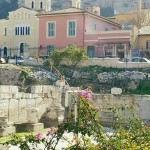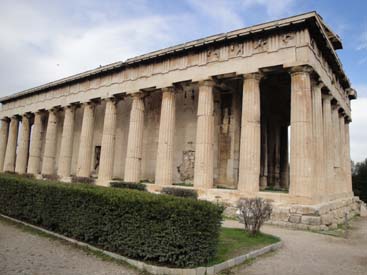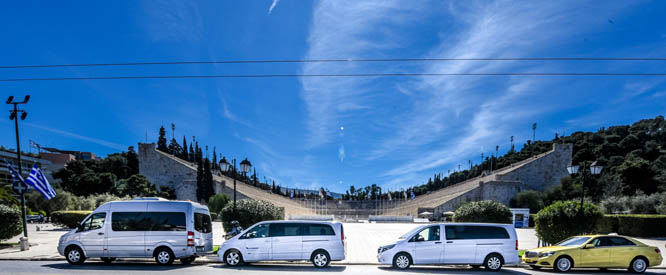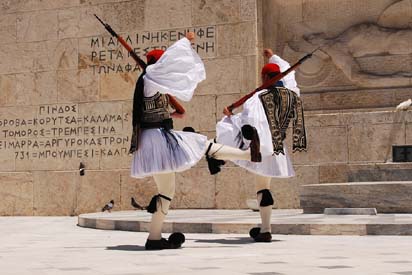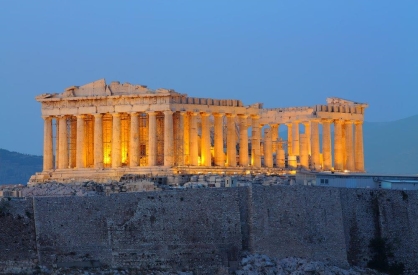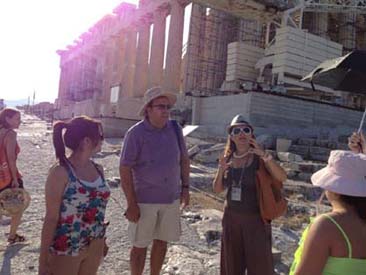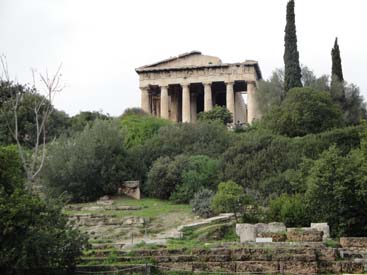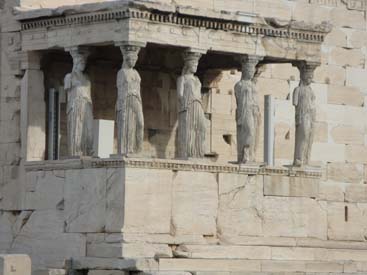Half Day Tours
- The Areopagus [Mars Hill] is a prominent rock outcropping located northwest of The Acropolis where Apostle Paul is said to have delivered the famous speech, “Now what you worship as something unknown I am going to proclaim to you. The God who made the world and everything in it is the Lord of heaven and earth and does not live in temples built by hands”.
- The Acropolis: “Parthenon” dedicated to Athena Parthenos, “Erechtheion” dedicated to Athena Polias, “Propylaea” the monumental entrance to the sacred area, “Temple of Athena Nike” dedicated to Athena-Apteros Nike, “Caryatides”, “Herodeon Theater”, the ruins of the “Theater of Dionysus”.
- The Greek Agora the civic, religious and commercial center of the Athenian life set with appropriate buildings like [Stoa of Attalus] and [Temple of Hephaistus]. It was one of the major Apostle Paul meeting points. Here, Apostle Paul spent a great part of his stay in Athens, trying to inform the Athenians on Christianity and give an alternative to the established religion of paganism.
Duration 4h.
- Entrance Fees (per person):
Acropolis [30 Euros], Greek Agora [20 Euros]
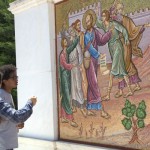
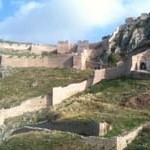
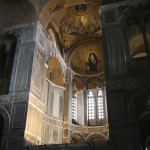
- The Battle of Thermopylae was fought between an alliance of the Greek city States, led by King Leonidas of Sparta and the Persians (Xerxes) over the course of three days, during the second Persian invesion of Greece. It took place simultaneously with the naval battle at Artemisium, in August or September 480 BC, at the narrow coastal pass of Thermopylae (“The Hot Gates”). The Persian invasion was a delayed response to the defeat of the first Persian invasion of Greece, which had been ended by the Athenian victory at the Battle of Marathon in 490 BC. Xerxes had amassed a huge army and navy, and set out to conquer all of Greece. The Athenian general Themistocles had proposed that the allied Greeks block the advance of the Persian army at the pass of Thermopylae, and simultaneously block the Persian navy at the Straits of Artemisium.
A Greek force of approximately 7,000 men marched north to block the pass in the middle of 480 BC. The Persian army, alleged by the ancient sources to have numbered over one million, but today considered to have been much smaller (various figures are given by scholars, ranging between about 100,000 and 150,000), arrived at the pass in late August or early September. The vastly outnumbered Greeks held off the Persians for seven days (including three of battle) before the rear-guard was annihilated in one of history’s most famous last stands. During two full days of battle, the small force led by Leonidas blocked the only road by which the massive Persian army could pass. After the second day, a local resident named Ephialtes betrayed the Greeks by revealing that a small path led behind the Greek lines. Leonidas, aware that his force was being outflanked, dismissed the bulk of the Greek army and remained to guard their retreat with 300 Spartans, 700 Thespians, 400 Thebans, and perhaps a few hundred others, most of whom were killed.
Duration 6h.
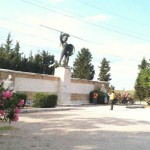
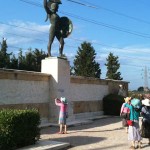
Full Day Tours
- Byzantine & Christian Museum: One of the most important public institutions in Greece, established in the early 20th century (1914) in order to collect, study, preserve and exhibit the Byzantine and Post-Byzantine cultural heritage in the Hellenic territory. The museum collection contains approximately 30,000 of works of art such as icons, sculptures, ceramics, ecclesiastical textiles, paintings, jewelries and architectural elements. The permanent exhibition is divided in two main parts: The first is devoted to Byzantium (4th -15th c. AD) and contains 1200 artifacts and the second entitled “From Byzantium to the modern era” presents 1500 artworks dating from the 15th to 20th century. Open: From November 1st to March 31st: Tuesday-Sunday: 09:30-17:30 Monday: closed. From April 1st to October 31st: Monday-Sunday: 08:00-20:00.
- Monastery of Kaisariani: lies at a short distance to the east of Athens, on a hillside at the foot of Mt. Hymettos. It is enclosed by a high wall with two gates, one on the east and one on the west side. The catholicon was built in the late 11th – early 12th century and was dedicated to the Presentation of the Virgin to the Temple. It is a cross-in-square, four-column church, with a dome, and its walls are built in the cloisonne masonry with poor brick ornaments. The domed narthex was added in the 17th century. About the same time, the barrel-vaulted chapel to the north, dedicated to Aghios Antonios, was added, too. The interior of the church is decorated with wall paintings dating from the 18th century while those in the narthex date back to 1682 and were made by Ioannes Hypatios, according to an inscription. Open Daily 08:30-15:00 except Monday.
- Monastery of Daphni which lies to the west of Athens, almost half-way along the ancient Sacred Way to Eleusis. The interior of the church is decorated with superb mosaics, dating from the end of the 11th century, a unique, fine example of the Classical idealism of Middle Byzantine art. The first excavations on the site were conducted in 1892 by D. Kambouroglou. In 1936-39 J. Travlos carried out excavations at the ancient temple of Apollo. In the course of the restorations during 1955-57, trenches were opened at several parts of the monument, especially at the chapel. Open Tuesday and Friday 08:00-15:00).
Duration 8h.
- Entrance Fees (per person):
Byzantine & Christian Museum [8 Euros], Monastery of Kaisariani [2 Euros].
- The Acropolis: “Parthenon” dedicated to Athena Parthenos, “Erechtheion” dedicated to Athena Polias, “Propylaea” the monumental entrance to the sacred area, “Temple of Athena Nike” dedicated to Athena-Apteros Nike, “Caryatides”, “Herodeon Theater”, the ruins of the “Theater of Dionysus” and finally “Areopagus” [Mars Hill].
- The Jewish Museum which was first established in 1977. Its collection includes more than 10,000 rare artifacts of great historical significance. This unique collection is continuously enriched and updated.
- The Temple of Zeus (which is the largest ancient temple in Greece in the Corinthian order), The Panathenaic Stadium ([Kallimarmaro], the original stadium built in the 1863 for the first modern Olympic games in 1896) for a short photo stop, The Old Palace, The Tomb of The Unknown Soldier in front of the Parliament & The Changing of The Guards.
- The Jewish Synagogue which is the oldest synagogue in Athens. It was built in 1906 and is currently used only during the High Holidays. The synagogue is maintained by the Jewish Community of Athens.
- The Plaka for lunch which is Athens’ oldest and most picturesque neighborhood. It is stone-paved, with narrow streets, and is full of gyros places, tavernas and souvenir shops.
- The Greek Agora which was the civic, religious and commercial center of the Athenian life set with appropriate buildings like [Stoa of Attalus] [now, since its restoration, is used as a Museum housing interesting findings] and [Temple of Hephaistus].
* Please note that The Jewish Museum and The Synagogue are closed on Saturdays so they are replaced either by The Roman Agora (where [Tower of Winds] stands [which is an octagonal pentelic marble clock tower]) or by The Acropolis Museum (collections: “Gallery of the Slopes of the Acropolis“, “Archaic Acropolis Gallery“, “Parthenon Gallery“, “Propylea- Athena Nike- Erechtheion” and “From the 5th c. BC to the 5th c. AD).
Duration 8h.
- Entrance Fees (per person):
Acropolis [30 Euros], Jewish Museum [10 Euros], Temple of Zeus [20 Euros], Greek Agora [20 Euros], Acropolis Museum [20 Euros].
- The Areopagus [Mars Hill] is a prominent rock outcropping located northwest of The Acropolis where Apostle Paul is said to have delivered the famous speech, “Now what you worship as something unknown I am going to proclaim to you. The God who made the world and everything in it is the Lord of heaven and earth and does not live in temples built by hands”.
- The Acropolis “Parthenon” dedicated to Athena Parthenos, “Erechtheion” dedicated to Athena Polias, “Propylaea” the monumental entrance to the sacred area, “Temple of Athena Nike” dedicated to Athena-Apteros Nike, “Caryatides”, “Herodeon Theater”, the ruins of the “Theater of Dionysus” and finally “Areopagus” [Mars Hill].
- The Canal which is about 6 km long and connects the Aegean Sea with the Ionian Sea.
- Ancient Corinth: “Peirene Fountain“, “Temple of Appollo” [6th c. BC with 1st c. AD restorations], “Bema of St Paul” Roman Forum, “Odeon“, “Amphitheater“, “Glauke Fountain“, “Long Walls” that begin at the summit of Acro-Corinth and descend all the way to Lechaion.
- The Bema: a large elevated rostrum standing prominently in the center of the Roman Forum of ancient Corinth and from where the city’s officials addressed the public. Probably because of the monument’s connection to Saint Paul, the Bema was transformed into a Christian church during the Byzantine period. The Bible, in the Book of Acts, records that Paul was brought for judgment before the proconsul Gallio on the accusation of conducting illegal teachings. Gallio, however, refused to judge what he considered to be a mere religious dispute among the Jews.
- Kenchreai: according to Acts 18:18, the Apostle Paul stopped at Kenchreai during his second missionary journey, where he had his hair cut to fulfill a vow, probably a Nazirite vow. Apostle Paul mentions the place and a deacon named Phoebe in the local assembly in his epistle to the Romans (Romans 16:1). Archaeological evidence indicates that trade with other Mediterranean regions continued into the 7th Century AD. A later ecclesiastical tradition recorded the existence of a bishop at Kenchreai, but the veracity of these accounts is hard to establish).
Duration 8h.
- Entrance Fees (per person):
Acropolis [30 Euros], Greek Agora [20 Euros], Ancient Corinth [15 Euros]
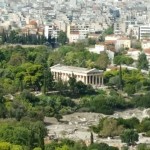
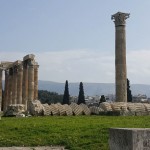
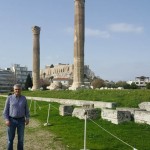
combines history with the natural beauties of Greece. Includes:
- The Canal which is about 6 km long and connects the Aegean Sea with the Ionian Sea.
- Ancient Corinth: “Peirene Fountain“, “Temple of Appollo” [6th c. BC with 1st c. AD restorations], “Bema of St Paul” Roman Forum, “Odeon“, “Amphitheater“, “Glauke Fountain“, “Long Walls” that begin at the summit of Acro-Corinth and descend all the way to Lechaion.
- Acro-Corinth: fortress Acropolis of Ancient Corinth and Medieval Corinth, being on a steep of a rocky hill 575 meters high at its highest peak, with uninterrupted views across the Corinthian and Saronic Gulfs.
- Nemea where you can taste some of the best wines made in the region [Agiorgitiko: Saint George].
Duration 8h.
- Entrance Fees (per person):
Ancient Corinth [15 Euros], Acro-Corinth [5 Euros], Nemea [10 Euros]
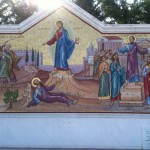

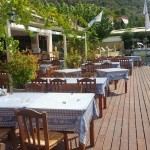
- the Canal which is about 6 km long and connects the Aegean Sea with the Ionian Sea. It cuts through the narrow Isthmus of Corinth and separates the Peloponnesian peninsula from the Greek mainland, thus effectively making the former an island. Although, it has been completed in the late 19th century, it was an idea and dream that dates back to over 2000 years. Emperor Nero (67 CE) had employed 6,000 slaves for the job. He started the work himself, digging with a golden hoe, while music was played. However, he was killed before the work could be completed. The cruise starts around 11:00 ΑΜ and lasts about 1h30m. Optionally you can extend the tour and visit some other popular sites of Peloponnese.
- Ancient Corinth: “Peirene Fountain“, “Temple of Appollo” [6th c. BC with 1st c. AD restorations], “Bema of St Paul” Roman Forum, “Odeon“, “Amphitheater“, “Glauke Fountain“, “Long Walls” that begin at the summit of Acro-Corinth and descend all the way to Lechaion.
- Acro-Corinth: fortress Acropolis of Ancient Corinth and Medieval Corinth, being on a steep of a rocky hill 575 meters high at its highest peak, with uninterrupted views across the Corinthian and Saronic Gulfs.
- Diolkos: a paved trackway near Corinth which enabled boats to be moved overland across the Canal.
- Nemea where you can taste some of the best wines made in the region [Agiorgitiko: Saint George].
Duration 8h.
- Entrance Fees (per person):
Ancient Corinth [15 Euros], Acro-Corinth [5 Euros ], Nemea [10 Euros], Cruise Ticket [30 Euros]
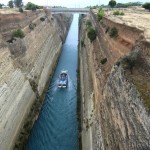
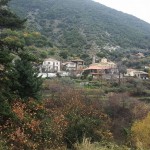
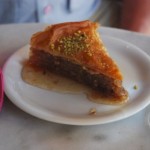
Lousios is a river and a gorge in western Arcadia that stretches from Karytaina north to Dimitsana in Greece. The river begins near Lykochori and flows through the Lousios Gorge. The river is treacherous and flows rapidly. It empties into the Alfeios 2.5 km northwest of Karytaina and south of Atsicholos. The river forms a deep, narrow gorge. Its length is approximately 15 km from north to south and its width is approximately 2 km wide. The gorge is very popular amongst hikers. At the northern end of the gorge lies the town of Dimitsana. At the southern end is the ancient city of Gortys with the temple of Asclepius. Much of the gorge is heavily forested, and there are steep cliffs.
According to tradition, the river took its name from Zeus, the father of the Olympian gods, who according to Pausanias washed at its sources after his birth. Pausanias also considered Lousios the coldest river in the known world. The Lousios gorge is also known as the “Mount Athos of the Peloponnese” on account of the many monasteries that dot its walls: the Timiou Prodromou, Philosophou, Aimyalon, Panagias Kalamiou monasteries, and the Church of St. Andrew in Gortys. The gorge also features several old water-mills for tabac and gunpowder production.
Duration 9h.
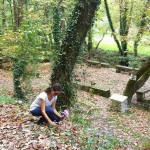
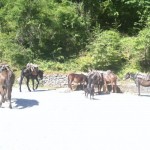

you will take the morning ferry from Piraeus port to Aegina and the trip will take about 1h20m.
- Aegina was the capital of Greece from 1827 to 1829. Aegina Town is situated on the west side of the island where the main port of the island is located. Agios Nikolaos, the tiny church, welcomes the visitor on approaching Aegina by sea. Numerous neoclassical buildings dominate Aegina Town, reminding the visitor of the glory of the island.
- The Archaeological Site of Kolona: was inhabited in prehistoric times through the classical period. Extensive walls and foundations have been discovered and excavations are still in progress. One erect column is all that remains of a Temple of Apollo built in the 6th c. BC.
- The Museum which contains a small but rich collection of pottery and sculpture from all periods of Aegina’s history. One of the most significant exhibits is the statue of the Sphinx (460 BC), which was dedicated to the Temple of Apollo. It is an extraordinary sculpture, with a head of a woman and a body that is half eagle and half lion, (Tues-Sun 08:30-15:00, Ticket: Full 3 Euros – Reduced 2 Euros)].
- The Church of Agios Nektarios which is named after its patron, Agios Nektarios, who died in 1920 and was canonised in 1961. His memory is celebrated by the Church on 9 November.
- The Temple of Aphaia stands on top of a pine-clad hill above Agia Marina. The first temple on the site (700 BC) was dedicated to Aphaia, a deity from Crete. The Doric temple we see today was built about 490 BC of local porous sandstone, On a clear day, you can make out the Temple of Poseidon at Sounion, as well as the Acropolis of Athens. It is said that the three temples form an isosceles triangle (the sacred triangle of antiquity). [Daily 08:00-17:00, Museum: Tues-Sun 08:30-14:15]. You will also have lunch in a nice taverna, swim in one of the best beaches and take the afternoon ferry back to Piraeus.
Duration 10-12h.
- Entrance Fees (per person):
Temple of Aphaia [10 Euros], Kolona [10 Euros]
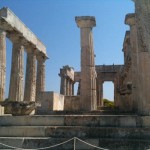
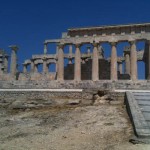
One Day Cruise
Please note that this is not a private cruise. It is highly recommended in the summer. The cruise ship holds about 350 passengers. The ship sails for the three beautiful islands of the Saronic Gulf at 08:00 AM. Shortly after departure, the trained staff will give you all necessary information about the ship, the three islands and the day’s itinerary. You will also have the opportunity to get answers to any questions you may have.
Hydra 1h45m visit
Our first port of call is Hydra. A beautiful small island, yet so great in history that stands out among many others! Elegance, tradition and majesty. These are the three key-words that point out the beauty and significance of the island that goes beyond what meets the eye. The cobblestone streets on the island, where donkeys are the primary mode of transportation, are lined with aristocratic mansions, forts, and churches steeped in history. The architecture of the island with the town of Hydra built in its center on the imposing rocky slopes has remained intact and unspoilt by modern interventions to our very days thanks to the Hydrants, who religiously keep this unique legacy that has been handed down to them by their ancestors from one generation to the next. Undeniably looking at the deep blue sea, staying away from noise and daily routine, swimming in the crystal clear waters, sunbathing and enjoying the Greek cuisine and hospitality are the best possible ways of spending one’s holidays, having the time of one’s lives and gathering invaluable memories as souvenirs in one’s hearts and minds.
Poros 50m visit
Poros is the island of peace, romance and relaxation. It is lush with pine trees which reach the rugged shores and the sandy beaches. Approaching Poros by ship, from afar, we can see the historical clock-tower on the highest hilltop. The architecture of Poros is a marvel right before your eyes. The beach houses are mostly neoclassical. The first houses were built in 1463 in the area around the clocktower. The centre of the town features the Town Hall, the Archaeological Museum, the Exhibition Hall and it is the site of a variety of cultural events. Within the narrow streets of Poros among the white houses and bougainvillea’s, there there are various shops, cafés, taverns and many bars with Greek and foreign music to excellently provide for all needs and tastes.
Aegina 2h visit
Aegina, the land of legendary Achilles! Aegina is the largest of the three islands. Apart from its harbor, there are numerous interesting sites to discover and there is a highly recommended optional tour, not included in the price. The ticket for the Guided Bus Tour of the island, which will include a visit to the Temple of Afea and the Church of Saint Nektarios, can be purchased on board. If you decide not to take a tour then you can stay in Aegina and either enjoy a walk/horse-carriage ride around the town or relax in one of the harbor’s charming waterfront coffee shops.
The pick up from the hotel in Athens center, the one day 3 island cruise to Aegina, Poros, Hydra and the drop off at the hotel will cost 179,00 Euros per adult and 128 Euros per kid (4 to 12 years old). Duration: About 12 hours Lunch on board and pick up/drop off at your hotel in Athens center (or, close to it) are included. NOT included: there are optional organized tours in air-conditioned vehicles visiting the Temple of Afea and the Church of Saint Nektarios [28 Euros per person], Hydra Walking Tour [31 Euros per person]. The above tours are sold on board at an extra cost.
VIP CLASS: cost 271 Euros per person.
VIP CLASS INCLUDES: Business class buffet(served in a separated area from standard class passengers).
Finger food first class.
Unlimited water, filter coffee, soft drinks. Walking tour in Hydra or Panoramic Tour in Aegina (Choice between one of these shore excursions). Visit to the cruise ship’s bridge and meeting with the Captain Discount on the ships boutique.Fast lane embarkation and disembarkation Round trip transfer from a hotel in Athens to the cruise ship and back.
ATHENS DAY CRUISE DETAILS: Embarkation Time: 07:10 – 07:40 a.m. Departure Time: 08:00 a.m.
Return time: 07:40 p.m.
Ports of Call HYDRA: 1 hour & 45 min
stay POROS: 50 min stay.
AEGINA: 2 hours stay.
Cruise Ticket Includes
Visit three beautiful islands of Saronic Gulf (Hydra –Poros –Aegina)
Lunch Buffet on board(certificate is provided).
Live music and folkloric show for entertainment
Port Taxes.


